KUBACHI, Dagestan — The cacophony of hammered silver reverberates through the sole school of this tiny village nestled in the lush and craggy Caucasus mountains of Dagestan.
Villagers in Kubachi, whose population is a mere 2,300, boast that every man, woman and child has mastered the ancient tradition of delicate silverwork, first brought to the region by Persian traders almost two millennia ago.
Teacher Kultum Kutsulova, clad in a flowing white hijab decorated with gold paisley teardrops she has embroidered, carefully watches over students etching elaborate, swirled flowers into silver and copper goblets and earrings.
"We are a blacksmiths' village, and we have it in our blood. Every child must know the work of their parents," she said in Russian, before switching back to her native Kubachi, a Caucasus dialect only spoken by the villagers.
Perched 2,000 meters in the Caucasus overlooking steep mist-covered valleys and ramshackle farms, Kubachi is 90 kilometers south of Makhachkala, the Caspian Sea capital of Dagestan, a republic that is home to more than 40 ethnicities.
An Islamist insurgency is raging in the North Caucasus, particularly in Dagestan, Ingushetia and Chechnya. In this turbulent trio, militants fueled by poverty and the ideology of global jihad stage near-daily attacks, and many want to carve out a separate sharia state.
"Even though this republic is suffering from so many problems, we have kept our culture," Kutsulova said.
Kubachi has retained its language and traditions. While men almost exclusively make and engrave silverware, women embroider hijabs and veils for their weddings, which often take place when they are just out of school.
Indira Ammalaimiyeva, 16, whose round gold earrings poke out from under her long black hair, said she wanted to follow her ancestors by learning the craft properly.
"I get married this summer, and I want to look the same as my grandmother did at her wedding," she said as fellow classmates chipped away in their weekly two-hour Kubachi art class.
A rarity in Soviet times, the village was granted permission by the Kremlin to teach the traditional art form 40 years ago in the state-run school.
Under communism, the Kubachi etched Soviet founder Vladimir Lenin on their silver and copper jugs. Now they have returned to their pre-revolutionary heritage styles of peacocks, flowers and embedded gems in layered petals. Sporting a shaggy white ram's wool hat, Kubachi elder Gadzhiomar Izabakrov, 79, showed off his lifelong collection of engraved silverware in his mini-museum that he keeps beside his living room.
"We're not just people who make special artistic treasures," he said. "We are hard-working people who believe in observing tradition."
A Message from The Moscow Times:
Dear readers,
We are facing unprecedented challenges. Russia's Prosecutor General's Office has designated The Moscow Times as an "undesirable" organization, criminalizing our work and putting our staff at risk of prosecution. This follows our earlier unjust labeling as a "foreign agent."
These actions are direct attempts to silence independent journalism in Russia. The authorities claim our work "discredits the decisions of the Russian leadership." We see things differently: we strive to provide accurate, unbiased reporting on Russia.
We, the journalists of The Moscow Times, refuse to be silenced. But to continue our work, we need your help.
Your support, no matter how small, makes a world of difference. If you can, please support us monthly starting from just $2. It's quick to set up, and every contribution makes a significant impact.
By supporting The Moscow Times, you're defending open, independent journalism in the face of repression. Thank you for standing with us.
Remind me later.


